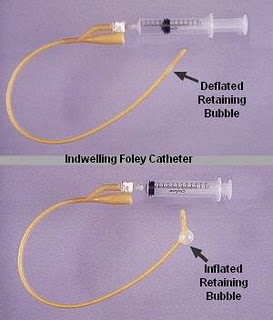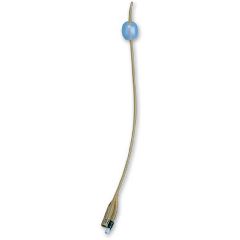A foley catheter is a flexible tube that is inserted to the urinary meatus to be indwelled in the urinary bladder in order to drain urine. Catheters are sized in units called French, wherein one French is equal to 0.33 millimeter. Sizes vary to cater pediatric and adult sizes of urinary passages. A very large diameter of a foley catheter may post a trauma when inserted to a small urethral passage while a very thin catheter may have leaks and may have inaccurate urine output measurement for patients requiring intake and output measurements. Catheter sizes vary from French 9 (smallest diameter) to French 48 (largest diameter).
Indwelling Foley Catheter Indications
Insertion of foley catheters are indicated for patients who are unable to go to the comfort room, for those who are at risk for fall, for those who have problems in the bladder or urinary system, for those receiving intravenous fluid, for those who are at risk for having bladder distention and for those who are in critical care settings. It is also used to accurately measure the urine output.
Catheter Insertion
The procedure in inserting a catheter is called Catheterization. This procedure requires sterile technique in order to prevent infections. It is also a must to take in consideration the universal precaution that when there is a potential for contact to a person’s body fluids, protective gears such as gloves, masks, protective gown and sometimes even goggles are worn to protect the health care provider.
The materials
- Sterile foley catheter
- Sterile gloves
- 10cc syringe
- Sterile Saline for Irrigation
- Urine Bag
- Kidney basin
- Cotton with Povidone Iodine Solution
- Sterile Water-based lubricant
How to Insert a Foley Catheter
As much as possible, it is important to maintain sterility throughout the procedure in order to prevent infections. Don the gloves and do perineal care. After the perineal care, get a new cotton with povidone iodine solution and apply it to the urinary meatus in a inner-to-outer circular motion. Apply the water-based lubricant to the tip of the catheter then insert it. Insert until the near-end of the catheter to ensure that it is in the urinary bladder. Once there is urine output, you are sure that it is in the urinary bladder and now you are ready to anchor it to prevent accidental removal of catheter. Never insist insertion to a erected penis or to a spastic meatus. You can teach the patient on how to relax muscles by doing deep breathing. It is a must to wait for the muscles to relax to prevent trauma secondary to insertion. Make sure that there is a urine output to check for patency. In some cases, the catheter may kink along the urethra that is why there is no urine output even though you have inserted up to the other end. To anchor the catheter, we inject 10 cc of sterile irrigating saline to the injection port then. Gently pull the catheter to check if there is a balloon. Attach it to the urine bag. Make sure that the urine bag is not folded and that the urine output flowed to the urine bag. Once the catheterization is finished always keep in mind that to maintain sterility, the catheter should never be disconnected when collecting urine specimen.
How to Remove a Foley Catheter
10cc balloon for anchorage
Removal of an indwelling foley catheter is a lot easier than inserting one. All you need to do is to aspirate 10 cc of the saline solution from the injection port. This will loosen the anchorage and make it ready for removal. Gently pull the catheter away from the meatus and discard the catheter and urine bag. It is also important to check for artifacts such as blood, pus or urine crystals in the tip of the catheter after removal. This may be a sign of a problem such as stones, bleeding or infection. Make sure that the volume of saline solution that you injected is the same as the volume that you will get after aspirating. In aspirating the fluid, make sure that when applying negative pressure, the lumen of the catheter where the port branches out should get thinner. Aspirate for any air that can be aspirated until the lumen thins. This is a sign that the balloon is really deflated because in some cases, only a small amount of saline solution is aspirated before removal of catheter but then when you actually pull the catheter away form the patient, there is still a small balloon left. This means that not all the fluid or air is removed after aspiration. A small or big balloon may traumatize the urethral passages and may cause scarring or stricture when it heals.

